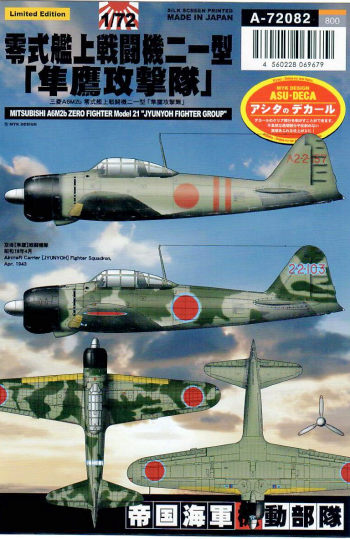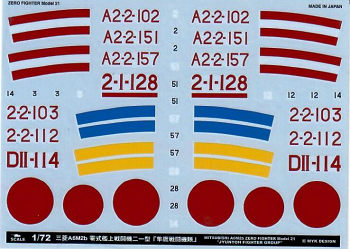 This is a
preview. I do not know how these decals perform.
This is a
preview. I do not know how these decals perform.MYK Design 72082: A6M2b 'Jyunyoh Fighter Group'
| SHEET #: | 72082 |
| PRICE: | 800 yen |
| REVIEWER: | Tom Hall |
 This is a
preview. I do not know how these decals perform.
This is a
preview. I do not know how these decals perform.
This sheet is exclusively markings for the air unit of the mid-size carrier Junyō for 1942 and 1943. The numerals are shaped right for wartime markings, and there are some for the landing gear doors. There are enough hinomaru for one plane; there are enough tail markings for seven.
It would have been helpful if MYK had placed the seven color profiles in chronological order to show the evolution of the tail markings. The subject is confusing enough for modelers, and it appears even the manufacturer is a little confused about it.
The earliest style for Junyō air unit is thought to be DII-, valid from around mid-May 1942 and possibly through October 1942. (There is a dearth of photos for her planes.) Probably fine for the attack on the Aleutian Islands in June, although I cannot confirm that airplane 114 was involved. MYK is maybe the only decal maker in this scale to go this early for Junyō planes. I think MYK did a good job choosing the yellow for the fuselage stripes.
Next would be the tail codes starting with “A”. The "A2-2" code is thought to have been displayed from November 1942 into at least January 1943. In January 1943, “A1” codes were seen on Zuikaku planes temporarily based at Rabaul.
 The next
style of tail marking has no letter. It came into use sometime between January
1943 and mid-April 1943, but MYK has dated one profile incorrectly as December
1942. This style is valid maybe into September
1943, but the modeler will want to paint some
field-applied camouflage for operations in April, or some factory-applied dark
green for a Nakajima-built Model 21 delivered after July 1943. One question is
whether the modeler will be inspired to use any of this style of tail marking.
MYK has not provided any history about the many air battles over the Solomon
Islands in which the Junyō air unit fought.
The next
style of tail marking has no letter. It came into use sometime between January
1943 and mid-April 1943, but MYK has dated one profile incorrectly as December
1942. This style is valid maybe into September
1943, but the modeler will want to paint some
field-applied camouflage for operations in April, or some factory-applied dark
green for a Nakajima-built Model 21 delivered after July 1943. One question is
whether the modeler will be inspired to use any of this style of tail marking.
MYK has not provided any history about the many air battles over the Solomon
Islands in which the Junyō air unit fought.
Nor have they provided any guidance about the red and blue fuselage stripes that they supply. There is a school of thought that for some period in the second half of 1942 the fuselage stripes were blue. This is likely a problem of interpreting b & w photos. The blue school may have started with Shigeru Nohara’s artwork in Famous Airplanes of the World 5 (1987, reprinted in Aero Detail 7). A Tamiya box top also shows blue. However, MYK depicts only red stripes in their profiles, and I suspect red is right. No doubt the answer lies in some papers from 1943!
MYK sells on eBay and shows their red decals there as a fairly vivid red, which is what attracted me to them. However, what arrived are decals in a much darker red (very close to FS 10076). This discrepancy makes me wonder if MYK has two different batches of the same sheet, or has adjusted the images of their products for the eBay listings. Perhaps influenced by a color photo from the Jeffrey Ethell Collection that shows dark red hinomaru on a faded Zero derelict, some decal makers choose this sort of dark red. However, I doubt that the Ethell photo is a good representation of the factory-painted hinomaru and probably will not use many of MYK’s red decals. (Editor's note: Back in the mid 1970s, when stationed on Guam, one of my favorite dives was a Zero that was in 50 feet of water. Even there, I was surprised at how bright the red on the Hinomaru was.)
| REFERENCES |
Aero Detail 7 Mitsubishi A6M Zero Fighter, Shigeru Nohara, Dai Nippon Kaiga Co., Ltd., 1993.
Japanese Naval Air Force Camouflage and Markings World War II, Donald W. Thorpe, Aero Publishers, Inc., 1977.
Japanese Naval Air Force Fighter Units and Their Aces 1932-1945, Ikuhiko Hata, Yasuho Izawa and Christopher Shores, Grub Street, 2011.
Sekai no Kessaku Ki (aka Famous Airplanes of the World) No. 5, Bunrindō, 1987.
April 2018
Copyright ModelingMadness.com
If you would like your product reviewed fairly and fairly quickly, please contact the editor or see other details in the Note to Contributors.